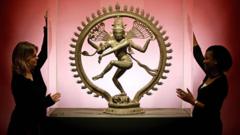The Chola dynasty, flourishing in southern India around the 11th century, significantly influenced economic trade and cultural practices in the region and beyond, leaving behind monumental architecture and artistic achievements.
Chola Dynasty: Unveiling India's Ancient Economic and Cultural Powerhouse

Chola Dynasty: Unveiling India's Ancient Economic and Cultural Powerhouse
Discover the remarkable legacy of the Chola dynasty, a hidden gem of India's medieval history.
The 11th century marks a thrilling chapter in history, particularly in southern India where the Chola dynasty emerged as a formidable power, largely unknown beyond its borders. Amidst Europe's fragmented states and the absence of iconic structures like Notre-Dame, King Rajaraja Chola was busy constructing the Brihadishvara temple, a monumental edifice rising 216 feet and built from an astounding 130,000 tonnes of granite. Gold, rubies, and pearls adorned the grand temple, alongside hundreds of exquisite bronze sculptures and vast treasures amassed during his reign, affirming Rajaraja as one of the wealthiest monarchs of his time.
The Chola family, starting as a minor faction in Tamil Nadu’s Kaveri floodplain, rose to prominence through their innovative approaches and cultural patronage. Notably, dowager Sembiyan Mahadevi revitalized the family's image, establishing a strong connection with devotees of the lesser-known deity, Nataraja. This dedication helped catapult Nataraja into a pivotal symbol of Hinduism, echoing the Cholas' artistic and spiritual innovation throughout their reign.
Rajaraja Chola's conquests were not just marked by territorial gains but also by strategic economic development. His military expeditions led to a presence in the island of Lanka and the Deccan Plateau, and the spoils of war funneled into the ornate Brihadishvara temple. The temple system was connected with extensive agrarian policies, especially the allocation of substantial rice harvests from the conquered lands, showcasing a well-organized economic structure unlike many contemporary states.
The Cholas were equally crucial players in the Indian Ocean trade, establishing strategic alliances with Tamil merchant firms and creating a synergy between commerce and governance that foreshadowed the East India Company’s later practices. Their maritime endeavors under Rajendra Chola revolved around the spice trade and the engagement with Southeast Asia, suggestive of a multicultural exchange rather than outright colonization.
During their reign, the Cholas became central to a vast trading network that transformed south India into a thriving economic hub. Their investments spawned intricate temple complexes acting as urban centers, populated by diverse communities across religions and ethnicities. Inquiries into their offerings reveal links with global markets, incorporating items like Egyptian copper and Indonesian sandalwood, which highlight an advanced understanding of global interdependence.
These developments extended into art and literature during the Chola period, with a flourishing of Tamil metalwork and poetic traditions surpassing the artistic movements of Europe. Renowned for their bronzes, especially the Nataraja figures, Chola artworks are now prominent in international museum collections, symbolizing a historical tapestry that is yet to be fully appreciated in global discourse.
Anirudh Kanisetti's insights through his book, "Lords of Earth And Sea: A History of The Chola Empire," invite us to delve deeper into this vibrant segment of history, where a blend of architectural marvels, cultural exchange, and economic innovation defined an era far ahead of its time.





















